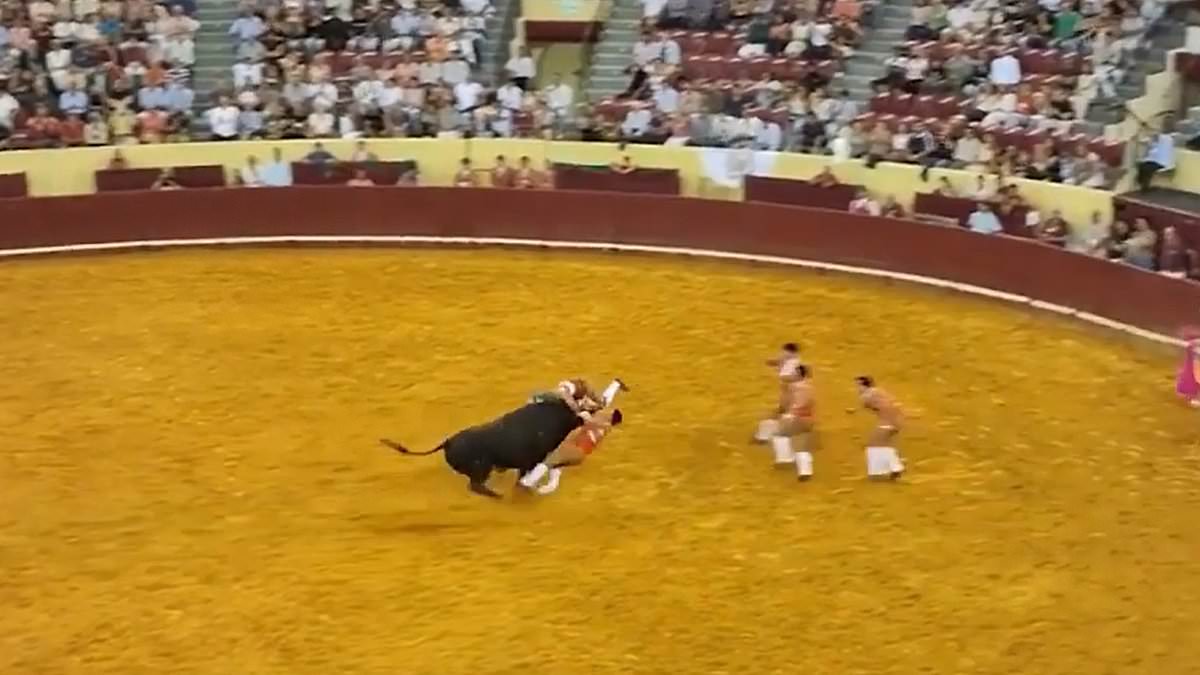This is the horrifying moment a renowned Portuguese bullfighter was killed after being picked up and rammed against a wall by an enraged 1,500lb beast.
Manuel Maria Trindade, a 22-year-old bullfighter, was making his debut performance in Lisbon’s Campo Pequeno bullring when the show ended in tragedy.
Footage from the event shows the young ‘forcado’ run towards the enormous bull to provoke the animal into charging as part of the ‘pega de cara’ (face catch) performance.
The beast then ran at high speed towards Trindade, who attempted to grab onto the animal’s horns and gain control.
But in a matter of seconds Trindade was hoisted up into the air by the storming bull and thrown against the wall of the arena.
Spectators in the 6,848-seat ring shouted in horror as the victim was left sprawled on the ground.
The animal was finally subdued by a bullfighter pulling its tail and others holding up bright capes in its eyeline. Paramedics rushed to treat Trindade in the ring but the injuries to his head were severe.
According to Portuguese news site Zap, a 73-year-old spectator watching the bullfight also died as the horror unfolded in the bullring below.
After the fight, bullfighter Trindade was rushed to São José Hospital where he was put in an induced coma, but he died within 24 hours on August 23 after going into cardiorespiratory arrest.
The spectator who died was Vasco Morais Batista, an elderly orthopedic surgeon from the Aveiro region who was watching the horrific fight from a box.
He was treated by Red Cross paramedics before being rushed to the Santa Maria Hospital where a fatal aortic aneurysm was detected.
Trindade was a young but celebrated forcado – the name of a kind of Portuguese fighter who deliberately provokes a bull into charging.
Once the animal is enraged, the team of eight forcados are supposed to form a single-file line and attempt, one by one, to jump on the bolting beast and wrestle it to a standstill.
Unlike in Spanish bullfighting, where the animal is killed by the matador at the end of the performance, bulls are not killed in the ring in the Portuguese tradition due to a royal law banning the ritual in 1836, and another explicitly banning killing bulls in 1921.
Instead, they are taken away later for professional slaughter – though occasionally beasts considered to have been particularly brave are ‘pardoned’ and retired to stud.
It is not clear what happened to the animal in Trindade’s case.
Forcados are unique to the Portuguese style of bullfighting and act on foot, without any protection or weapons.
Before he was completely dominated by the animal, Trindade was attempting a pega de cara (face catch), by grabbing the bull’s horns. If the stunt had been successful, Trindade’s fellow forcados would have joined him by clambering onto the animal and wrestling it to the ground to the point of submission.
The promising 22-year-old fought for the São Manços amateur bullfighting troupe, which was celebrating its 60th anniversary this year.
He was from Nossa Senhora de Machede, in the municipality of Évora.
Trindade was continuing a family tradition by pursuing bullfighting and followed in the footsteps of his father who was also a forcado with the São Manços group.
The company responsible for organising Friday’s bullfight sent its ‘deepest condolences to the family, to the Grupo de Forcados Amadores de S. Manços and to all of the young man’s friends’.
Lisbon’s Campo Pequeno was built in the 1890s and is the home of Portugese bullfighting in the summer season.
Bullfighting has a rich history in Portugal and dates back to the late 16th century with the erection of the first-known ring in Lisbon.
In a separate bizarre incident in Spain, a man was violently upended by a bull with flaming horns at a festival.
After being provoked by a crowd, the enraged animal charged towards the reveller and flipped him over multiple times before he was able to escape through safety barriers.
The sequence of events occurred during an annual festival in Alfafar on the outskirts of the eastern Spanish city of Valencia.
The bull let loose on the street is known locally as a ‘bou embalat’.
The controversial practice has been heavily criticised by animal rights activists, who two years ago filmed sickening scenes of a bull with flaming torches attached to its horns knocking itself out after smashing into a wooden box.
